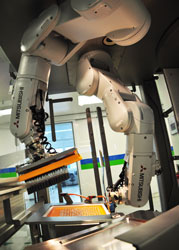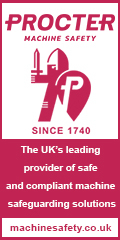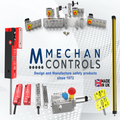
Posted to News on 31st Jul 2014, 15:29
Coordinated syringe handling by Mitsubishi Electric robots
The pharmaceutical industry sets high standards in respect of hygiene, quality and performance, and these standards apply to pharmaceutical packing facilities too. Space is also often at a premium in production plants, chiefly due to how they have grown historically, and new additions to the machinery stock must therefore be as compact as possible. Robotronic AG specialises in robot-aided handling systems that meet these strict size requirements. The Swiss company works with a modular robot cell developed in house, termed Modular Robot Technology or MRT for short. Only Mitsubishi Electric robots are used in this system.

Robotronic has developed a handling module for supplying ready-to-use syringes to the final packing facility of an international pharmaceutical company in Germany. The company, a longstanding customer of Robotronic, was urgently seeking a flexible systems that could be implemented in a construction period of four to five months. The space available was very tight at roughly three square metres, and a supply rate of 400 syringes per minute was stipulated. The system also had to permit switching between different syringe carriers and syringe formats ranging from 0.5 to 10 millilitres.
By applying the modular principle, Robotronic is able to combine any Mitsubishi Electric robots in a cell with other elements such as conveyor belts, camera systems or linear axes. Mike Weber, managing director of Robotronic AG, says: "We can save a lot of time in design and construction using the modular principle. The basic framework is always present and only has to be fitted out according to the requirements, which keeps procurement costs relatively low. The extremely compact design is an important advantage, enabling us to work in a very small space." The basic module of the MRT occupies an area that is barely the size of a euro pallet, measuring 1.0 by 1.30m, and is around 2.20m tall.
Every syringe packing line requires a special supply system, because syringes have no base on which to stand. They are therefore transported and stored suspended on a so-called "finger flang", for which special carriers are necessary. The two most common carriers are standardised combs and nests, which hold 160 syringes respectively. To pack the syringes, they must be removed from the combs or nests and transferred to the packing facility. This calls for extreme sensitivity, because the glass syringes are easily breakable. As Mike Weber also explains: "Similar handling machines have been around in the market for a long time, but what makes the MRTs from Robotronic unique is their small footprint. A comparable machine from another manufacturer takes up three to four times as much room. This is something which is normally in short supply in production plants and makes the space available extremely expensive."
Compact overhead articulated-arm robots
Two type MELFA RV-4FL robots from Mitsubishi Electric are used in the syringe handling system. These are compact overhead articulated-arm robots with six axes. No other mechanical elements such as lifting or rotating components are required. Mike Weber says: "We attach importance to using only robots where possible and only using additional mechanical elements, which may be susceptible to malfunctions, in exceptional cases. A robot usually operates for years without any problems, thereby ensuring a high output of our MRTs."
Part of the system is a supply system for the tubs, i.e. the thermoformed plastic containers in which the combs or nests are transported. Conveyor belts are normally used for this, but they take up a comparatively large area. Robotronic, on the other hand, uses a rotary turret that it has developed and that sits on the same basic framework as the robot cell to which it is connected. The turret is loaded manually on the outside with up to ten full tubs before rotating 180 degrees and being emptied by robot.
Mike Weber explains: "Stacking the tubs in the rotary turret enables us to reduce the footprint considerably compared with a conveyor line. We process two and a half tubs or 400 syringes per minute. The turret holds ten tubs in all, so it has to be reloaded every four minutes. A rotary turret for 20 tubs is also optionally available. To achieve the same autonomy with a conveyor belt, the belt would have to be four metres long. With the MRT we achieve this output in a metre."
Incorporated into the custom equipment are two MELFA robots of type RV-4FLM-Q1-S15, the related CPUs Q172DRCPU and a PLC CPU, type Q03UDECPU. The rotary turret is driven by a Mitsubishi Electric MR-J4 servo motor with motion CPU Q172DCPU. All CPUs form part of the iQ Platform, a multi-CPU platform from Mitsubishi Electric. The special feature of this system is that the robots are not only suspended overhead but also work in pairs in the minimum of space.
The two MELFA robots are responsible for the complete handling of tubs, carriers - i.e. nests or combs - and the different syringe formats, and are precisely coordinated for this purpose. The process sequence for combs, in which the syringes are suspended behind one another in several rows, is as follows: first robot A removes a tub from the first turret shaft and places it in the station provided. Here robot B removes the comb and robot A returns the empty tub to the rotary turret. Robot B transports the comb to the emptying rail, tilts it slightly and clocks the syringes through. From the rail the syringes enter the normal packing process. Robot B then deposits the empty comb in a separate station, from where it is picked up by robot A and placed in the tub in the second turret shaft.
Vacuum grippers
The ability of the MRT to process both combs and nests is a unique feature in the industry, according to Mike Weber. The nests have a honeycomb structure with individual openings in which the syringes are suspended. Vacuum grippers are required for the handling process. The machine can be converted in a matter of minutes, and the handling process differs as follows: here, too, robot A first places the tub in the first station. Robot B removes the nest by means of the vacuum, transports it to the second station and places it in a stepped block, above which the syringes are raised slightly. Using a special gripper, robot A travels to the honeycombs in the nest, takes up the syringes on the finger flange and moves them to the emptying rail. Here it clocks the rows through for emptying, as with the combs. Then robot A places the emptied nest and tub in the second turret shaft of the rotary station.
The current MRT model can achieve a cycle rate of 400 syringes per minute into the emptying rail, but the system can process up to 600 units per minute. To do this, a further axis is added to the system, driven by a Mitsubishi Electric servo motor MR-J4. Mike Weber says: "600 syringes per minute is pretty much the fastest rate that you'll find anywhere in the world!"
The additional axis permits a faster emptying process. The robot itself no longer travels to the emptying station to clock the syringes through in rows; instead all syringes are emptied in one passage in a 180-degree tilting movement from the comb into an opposing receptacle located on the servo axis. Instead of the robot, the servo axis empties the honeycombs in a tilting movement. The original movement sequence of the robot is shortened, making it possible to process up to 600 syringes per minute.
As the exclusive robotics distribution partner of Mitsubishi Electric for the Swiss market, Robotronic has been working with the supplier of automation systems since it was first established in 2008. Mike Weber himself has over 30 years' experience of working with Mitsubishi Electric. The most important factors in his eyes are the fast, competent customer service and the global availability of technology and experts. Of the products he says: "The robots exhibit outstanding flexibility, speed and reliability over many years. For example, Mitsubishi Electric robots belonging to one of our customers have been working in three-shift operation for an unbelievable 25 years. That's a huge achievement! And other components from Mitsubishi Electric, such as servos or controllers, have never caused us quality problems. The high degrees of freedom on installation of the robots are also advantageous, due for example to the overhead assembly or the extreme rotary movements. The slimline design of the robots helps us to realize the MRT in the minimum of space."
Further development in full swing
Robotronic is developing the current syringe handling module further and aims to offer the option of switching to a third carrier format, so-called rondo trays, in the future. These are flat, rippled plastic trays 300 millimetres long, into which the syringes are clipped adjacent to one another. Mike Weber comments: "If the MRT can also process rondo trays, our customers are able to handle all three formats using just one solution."
Robotronic is also working on a system in which the syringes are moved contactlessly to the next machine on a conveyor line. The use of glass in pharmaceutical and food production poses a risk, as glass containers are easily damaged on impact. In the case of syringes, the finger flange could be damaged, for example, or glass particles could get into the liquid. Robotronic is reacting with the new system to the "No Glass Contact" recommendation of the US Food and Drug Administration (FDA). The systems manufacturer is looking to pharmaceutical companies worldwide with its special offering. As Mike Weber says: "The system can be adopted directly in other countries because the nests, combs and rondo trays are standardised and used internationally."
The next challenge Robotronic set itself was to construct a handling system to be exhibited at the components fair, held in Dusseldorf, Germany, 8th-14th May 2014. Mike Weber described the project as follows: "We constructed an MRT cell for handling syringes in nests in just three months. We demonstrated thereby how quickly we can realise orders in practice by means of the MRT modular principle. Ordered in February, delivered in April - that's a record! The normal timescale for a project of this kind is in the order of nine to twelve months in normal custom machinery manufacture."
To learn more about Mitsubishi Electric robots in pharmaceutical packing, please visit gb3a.mitsubishielectric.com.
Want the latest machine building news straight to your inbox? Become a MachineBuilding member for free today >>

















